Over the years, the United States has produced many remarkable generals and admirals, but only a few have stood out as world-class strategists and leaders of troops. As Veterans Day approaches on November 11, let’s remember and celebrate them. Here is my list of America’s finest 11 commanders.
Ulysses S. Grant, 1822 – 1885 (Civil War)
No U.S. military man in history rose from such humble beginnings and abject failure to be so successful and world-renowned as did Hiram Ulysses Grant. He was a simple man with simple tastes — for breakfast he ate vinegar-soaked cucumbers and he was so revolted by the sight of blood his meat had to be cooked extra-well. To those who knew of his pre-war string of bad luck and business disappointments, this cigar-chomping, taciturn soldier seemed a most unlikely savior of the Union. As one Northern journalist put it: “How profoundly surprised Mrs. Grant must have been when she woke up and learned that her husband was a great man.”
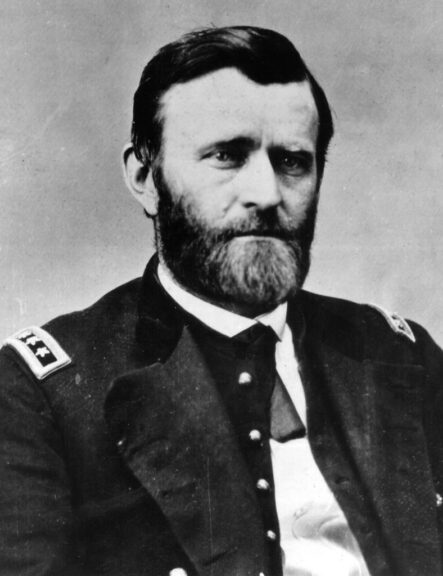
U.S. General Ulysses S. Grant. (Photo by National Archive/Newsmakers)
But greatness comes in many forms. And what Grant lacked in refinement (he once claimed he only knew two songs “one of them is ‘Yankee Doodle’ the other isn’t”) he made up for in drive and vision and understanding of the true character of this modern war into which the nation had foolishly plunged far better than most of his contemporaries. And he knew how to win battles. Perhaps his good friend Sherman summed up Grant the best when he offered that, although Grant wasn’t as smart or as knowledgeable of the intricacies of war as he, “I’ll tell you where he beats me though and where he beats the world. He doesn’t give a damn about what the enemy does out of his sight, but it scares me like hell!”
Grant first rose to fame in the Western Theater in February 1862 by capturing Fort Henry and then Fort Donaldson, famously telling the surrounded Confederates who asked for terms, “No terms except unconditional and immediate surrender will be accepted.” Northerners cheered, offering that the “U.S.” in Grant’s name (a clerical error upon his arrival at West Point) stood for “Unconditional Surrender.”
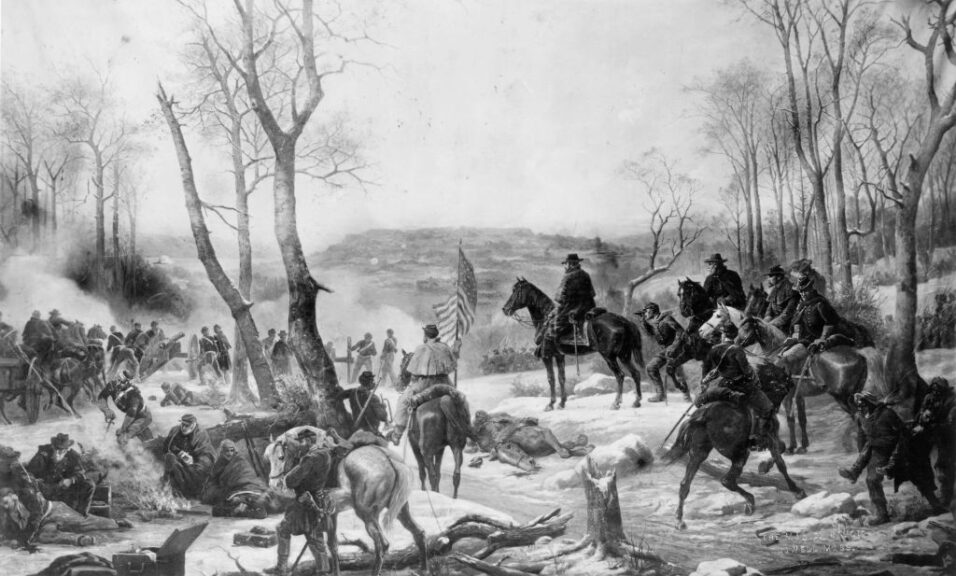
7th February 1862: General Grant (1822 – 1885), right of center, on horseback, watches his troops attack Fort Donelson, Tennessee. (Photo by MPI/Getty Images)
He then moved to confront the main Confederate army at Corinth, Mississippi, which was a vital Southern railroad hub. But in April 1862 the rebels attacked first, hitting him hard at his encampments at Pittsburg Landing on the Tennessee River. For two days the brutal fighting raged around the little Shiloh church, from which the battle gets its name. The casualties, ten times those of First Bull Run, shocked all engaged. Grant, though surprised by the sudden onslaught, kept his cool and called in reinforcements.
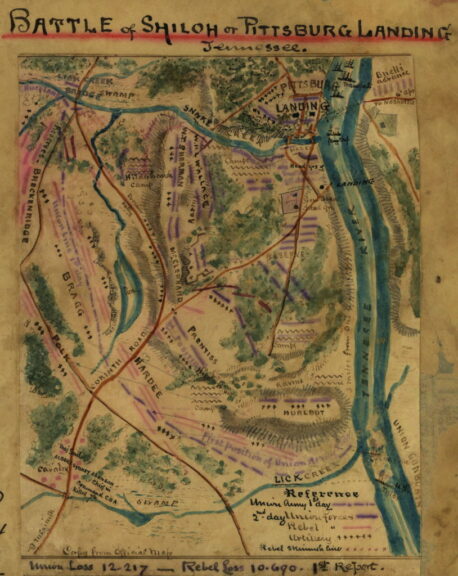
UNITED STATES – CIRCA 1862: The Battle of Shiloh, also known as the Battle of Pittsburg Landing, was a major battle in the Western Theater of the American Civil War, fought on April 6 and April 7, 1862, in southwestern Tennessee. Hand Drawn Map (Photo by Buyenlarge/Getty Images)
After the first day’s battle, Grant was sitting alone contemplating the horrors he’d witnessed and how close to disaster he’d come, when Sherman approached him. “Well, Grant,” he said. “We’ve had the devil’s own day, haven’t we?” Grant replied: “Yes. Lick ‘em tomorrow, though.” And he did. But the Civil War had entered a new and far bloodier phase.
Grant’s objective throughout the rest of 1862 into 1863 was the capture of Vicksburg on the Mississippi, the so-called “Gibraltar of the South.” Here the perseverance that would make Grant the most effective commander of the war was on display. He tried several lines of advance to get at the citadel city, only to be turned back. After one failed attempt, a Confederate asked a Union prisoner: “Hasn’t that old fool Grant tried this ditching and flanking five times already?” The Yankee answered: “Yes, but he’s got thirty-seven more plans in his pocket!”
Finally in April 1863, in a risky operation, Grant sent Union gunboats under Adm. David D. Porter to run right under the teeth of rebel batteries on Vicksburg’s bluffs overlooking a hairpin turn in the Mississippi while he marched south down the west bank of the river and awaited the navy’s arrival. He then ferried his army across the wide river and marched his mobile army inland through the Mississippi hinterland, fighting a series of flanking battles that drove the Confederates back into their entrenchments on the river. Grant then laid siege to the city.
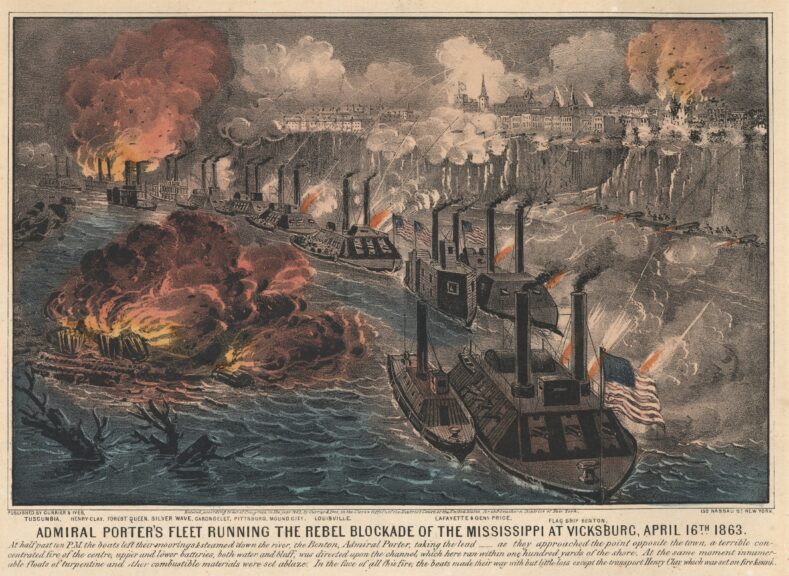
“Admiral Porter’s Fleet Running The Rebel Blockade Of The Mississippi At Vicksburg, April 16th 1863.” Hand colored lithograph by Currier and Ives, New York, 1863. Missouri History Museum Photograph and Prints collection. Civil War. P0084-1183. Wiki Commons.
On July 4, 1863, the day after Lee’s defeat at Gettysburg, the exhausted and starved Confederates surrendered. Vicksburg, which Lincoln described as “the key” to the war, was finally in Grant’s possession; the Union now had control of the entire Mississippi, and the Confederacy was effectively cleaved in two. Some historians consider Vicksburg the most significant Union victory of the war for its monumental strategic importance. Its capture was a truly remarkable feat of war, and earned Grant well-deserved accolades.
It may have been during this time, as with earlier periods in the war when the guns were silent, when Grant, sorely missing his family and with nothing to do during the siege but wait it out, fell into a period of drinking that earned him ridicule from some Northern detractors. But Lincoln, recognizing that in Grant he’d found his winning general, famously quipped he wanted to find out what brand of whiskey he drank so he could send a case to all his generals, declaring, “I cannot spare this man. He fights!”
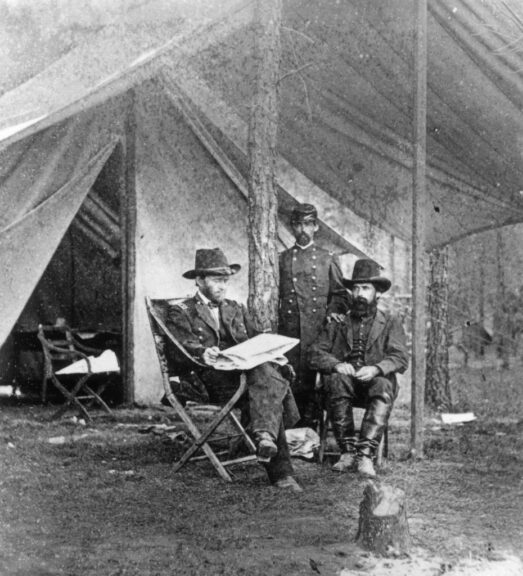
1864: Union General Ulysses S. Grant (left) sitting with two men in front of a tent at camp during the U.S. Civil War. (Photo by Hulton Archive/Getty Images)
After the Confederate victory at the brutal Battle of Chickamauga in northern Georgia in September 1863, the rebel army chased the retreating Yankee Army of the Cumberland back to Chattanooga, Tennessee. In command of the heights overlooking the town, the rebels laid a siege of their own. Lincoln ordered Grant, now in charge of the Division of the Mississippi — which contained three Union armies of the Cumberland, Tennessee, and Ohio — to the besieged city. Arriving in October 1863, Grant set about fortifying Chattanooga and opening a desperately needed supply line while making preparations to lift the siege. In November 1863, his men stormed the enemy positions on the high ground of Missionary Ridge and then Lookout Mountain, and sent the Confederates retreating back into Georgia.

General Ulysses Simpson Grant (1822�1885), with members of his staff after the Battle of Chattanooga, Tennessee on 25 November 1863. (Photo by Archive Photos/Getty Images)
By March 1864, Grant had been promoted to Lieutenant General, a rank only held once before by none other than George Washington, and was given command of all Union armies. Although expected to run the war from a desk in Washington, D.C., the hands-on Grant had no such plans. Rather, he would stay in the saddle, attaching himself to Gen. Meade’s Army of the Potomac, while giving his most reliable subordinate, the brilliant William T. Sherman, field command of the western armies. For Grant, the main impediment to Union victory was Robert E. Lee’s Army of Northern Virginia. So he instructed Meade, “Where Lee goes you go. And I will go with you.”
Although completely unintimidated, Grant found the Eastern Army to be strangely terrified of Lee. In exasperation, he once scolded his officers: “I’m damned tired of hearing about what Lee’s going to do to us! Start thinking about what we’re going to do to him!”
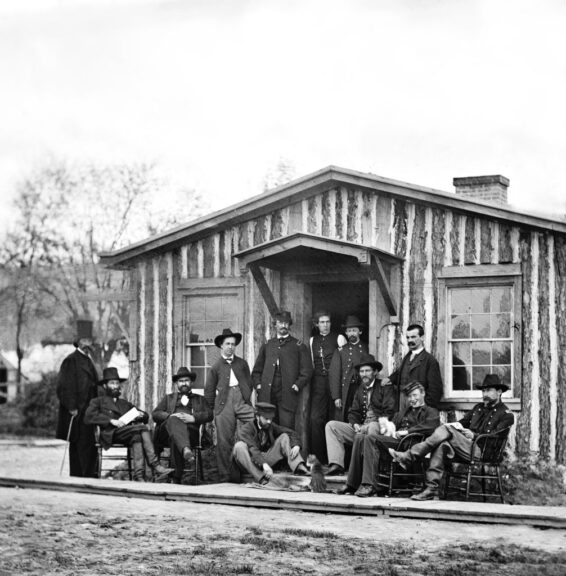
Members of General Ulysses S. Grant’s Staff, City Point, Virginia, USA, Mathew B. Brady, April 12, 1865. (Photo by: Glasshouse Vintage/Universal History Archive/Universal Images Group via Getty Images)
In May 1864, Grant first confronted Lee in combat at the two-day bloodbath that was the Battle of the Wilderness around the Chancellorsville battlefield. Like Chancellorsville, the Wilderness was, in fact, a tactical defeat for the Army of the Potomac. Grant suffered a horrific 18,000 casualties while inflicting 12,000 on Lee. But Grant understood that he could replace his losses whereas Lee could not. Thus, where the veterans expected a retreat to regroup before trying again, as they had done so often in the past after such battles, Grant ordered his army to march south, not north. When the men realized this, cheers burst out. “Ulysses don’t scare worth a damn!”
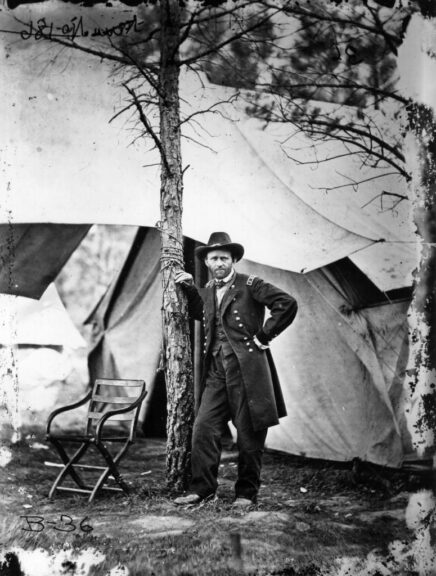
American General Ulysses Simpson Grant (1822 – 1885), later the 18th President of the United States of America, at his headquarters City Point during the American Civil War. He led the Union army to victory. (Photo by Mathew Brady/Getty Images)
Still, throughout the summer of 1864, Grant’s stellar reputation was shattering. The victor of Fort Henry, Fort Donaldson, Shiloh, Vicksburg, and Chattanooga, had been the toast of D.C. when he arrived to take command. But by July 1864 “Unconditional Surrender” Grant was instead being called “The Butcher.” His unrelenting Overland Campaign in which he fought a steady stream of brutal engagements with Lee’s determined army while advancing towards Richmond certainly inflicted heavy losses on Lee, as was Grant’s intention. But he’d also practically wrecked the Army of the Potomac in the process, losing over 50,000 men in less than two months of non-stop fighting from The Wilderness to Spotsylvania, to Cold Harbor and Petersburg. But Grant was undeterred, vowing “I propose to fight it out on this line if it takes all summer.”
The losses Grant suffered in Virginia, which shocked the North, belied his military genius, for he’d been the only Union army commander until Meade at Gettysburg to decisively whip the Confederates in battle. And his marching and maneuvers and use of terrain and back roads to out-general his rebel opponents in the West are sometimes lost in his story given the bloodlettings against Lee to follow. Perhaps Grant’s true genius was his ability as a national army commander (Meade was still technically head of the Army of the Potomac, although Grant’s accompanying him on the march directing the campaign made the role nominal.) Grant could see the big picture and how the separate Union armies — Sherman in Georgia, Sigel in the Shenandoah, Butler on the James, and Banks in Louisiana — needed to work in concert and apply pressure at all points until the shell cracked and collapsed. The shell finally cracked in Georgia.
When Sherman took Atlanta in September 1864, it became clear to the Union that Grant had to fight hard in Virginia to keep Lee in place to prevent Georgia’s relief. And in April 1865, just eleven months after beginning his drive to Richmond, Grant would accept Lee’s surrender at Appomattox.
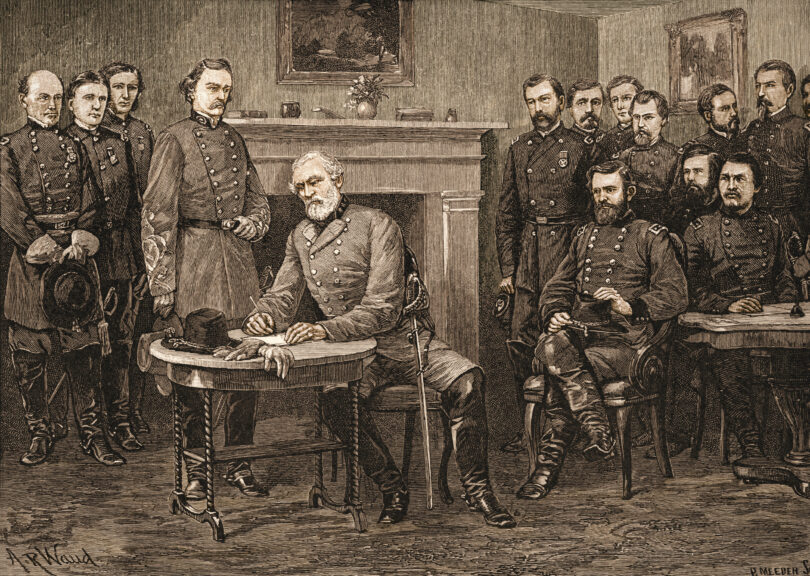
Confederate General Robert E. Lee (1807 – 1870) (center) surrenders to Union General Ulysses S. Grant (1822 – 1885) (seated to right of Lee) at Appomattox Court House, which effectively ended the American Civil War, Virginia, April 9, 1865. (Photo by Stock Montage/Getty Images)
As with Washington and MacArthur, Grant’s greatness on the battlefield flowed into his magnanimity in victory. The terms Grant offered the dejected Lee — no man would be tried for treason if they declared loyalty to the Union and returned home, all may keep horses for planting, officers can keep firearms and personal effects — did much to begin the healing of the nation. He was acting out his president’s edict: “With malice toward none and charity for all.” Perhaps there are no greater illustrations of just how important was Grant’s generous conduct towards a defeated enemy after a vicious war than the letters of many Confederate veterans he received while dying from cancer. As one former enemy wrote:
…Be assured that I am not the only ex-confederate who sends his prayers daily to the throne of Grace for the restoration of the Grandest, the noblest the bravest Soldier and the Purest Statesman whoever graced the annals of history. That [God] may restore you to health & friends is the fervent prayer of one who at 16 years of age entered the lists against you and accepted the magnanimous terms you accorded us at Appomattox.

Portrait of Ulysses S Grant, General in the Union army in the American Civil War and then President of the USA, on a house porch reading. Thought to be the last photograph taken of the general before his death, 1890. (Photo by Afro American Newspapers/Gado/Getty Images)
* * *
America’s Top 11 Generals
RELATED: #6 Admiral Chester Nimitz
RELATED: #5 Thomas ‘Stonewall’ Jackson
RELATED: #4 William T. Sherman
* * *
Brad Schaeffer is a commodities trader, columnist, and author of two acclaimed novels. His newest book, the fact-based LIFE IN THE PITS: My Time as a Trader on the Rough-and-Tumble Exchange Floors will be published in December and is currently available for pre-order. You can also find more of Brad’s articles on Substack.
The views expressed in this piece are those of the author and do not necessarily represent those of The Daily Wire.

Continue reading this exclusive article and join the conversation, plus watch free videos on DW+
Already a member?

.png)
.png)

